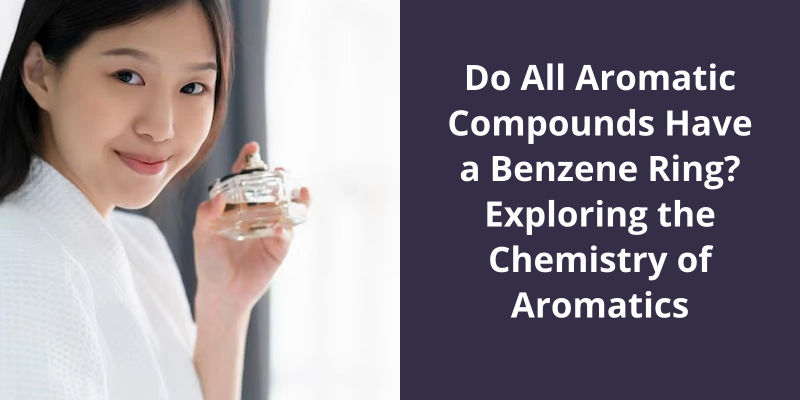Not all aromatic compounds have a benzene ring. An aromatic compound is a type of compound that contains a cyclic and planar arrangement of atoms, with each atom in the ring having an unpaired electron in a p-orbital. While the benzene ring, a hexagonal ring of six carbon atoms with alternating single and double bonds, is a common structure in aromatic compounds, there are many other aromatic compounds that contain different ring structures. For example, pyridine and furan are aromatic compounds that do not contain a benzene ring. They contain nitrogen and oxygen atoms in their ring structures, respectively. So, while benzene rings are common in aromatic compounds, they are not a necessary component.

Which Aromatic Compounds Are Not Benzene?
Benzene is a well-known aromatic compound that contains a ring of six carbon atoms with alternating double bonds. While it’s the most common aromatic compound, there are many other organic compounds that also demonstrate aromatic properties. These are called non-benzene aromatic compounds.
One example of a non-benzene aromatic compound is furan. Furan is a heterocyclic compound that contains a five-membered ring with four carbon atoms and one oxygen atom. It’s commonly found in various natural sources, including essential oils, and is used in the production of various chemicals like pharmaceuticals and plastics.
Another non-benzene aromatic compound is pyridine. Pyridine is a heterocyclic compound that contains a six-membered ring with five carbon atoms and one nitrogen atom. It’s commonly used as a solvent and is also present in various natural sources like tobacco leaves.
Other examples of non-benzene aromatic compounds include thiazole, thiophene, and imidazole. Thiazole contains a five-membered ring with a sulfur atom and nitrogen atom, while thiophene contains a five-membered ring with a sulfur atom. Imidazole contains two nitrogen atoms in a five-membered ring.
Non-benzene aromatic compounds are important in various fields, including pharmaceuticals, agrochemicals, and materials science. They exhibit unique properties that aren’t found in benzene compounds, and their use is constantly being explored for potential application in these fields.
These compounds play a vital role in the development of new materials and the production of various chemicals.
Aromatic hydrocarbons are a type of organic compound known for their distinctive ring structure. These rings, often containing benzene or similar structures, give these compounds their unique properties and make them important in fields ranging from chemistry to materials science. While they may seem simple at first glance, the intricacies of these rings and their chemical properties make them an interesting topic of study.
Are Aromatic Hydrocarbons Ring Shaped?
Firstly, not all aromatic hydrocarbons have the same ring structure as benzene. In fact, there are many variations of the ring structure, with different arrangements of double and single bonds. These variations give rise to a wide range of aromatic compounds, each with their own unique properties and applications.
They can also be found in other types of molecules, such as heterocyclic compounds, which contain atoms other than carbon in the ring structure. Examples include pyridine, which contains a nitrogen atom in the ring, and furan, which contains an oxygen atom.
Thirdly, the properties of aromatic compounds are largely determined by the aromatic ring structure. For example, the delocalized electrons in the ring give rise to a unique stability and reactivity profile, making aromatic compounds highly useful in a variety of applications, from drugs to plastics.
Fourthly, the term “aromatic” is actually a historical designation, based on the observation that many of these compounds have a pleasant smell. However, not all aromatic compounds have a distinct odor, and many have been synthesized purely for their chemical properties, rather than their smell.
Finally, the study of aromatic compounds and their properties is an active area of research in both organic and inorganic chemistry. Understanding the electronic structure and reactivity of these compounds is essential for developing new materials, drugs, and catalysts, as well as for understanding natural processes such as photosynthesis. As such, the role of aromatic rings in chemistry is far-reaching and continues to be a subject of intense interest and investigation.
The Synthesis and Industrial Applications of Aromatic Compounds
- Development of various methods for the synthesis of aromatic compounds including aromatic substitution, nucleophilic addition reactions, and more
- Application of these methods to the production of a wide range of industrially important aromatic compounds such as benzene, toluene, xylene, and more
- Industrial uses of these compounds in the manufacture of products such as plastics, synthetic fibers, pharmaceuticals, dyes, and more
- Ongoing research and development in the field of aromatic compound synthesis and their applications to address emerging industrial needs and challenges
Source: Aromaticity
While the concept of aromaticity is centered around a continuous ring of p-orbitals, the question remains: do these rings have to be the traditional circular shape that we often associate with the word “ring”? Interestingly enough, it turns out that not all aromatics have to be rings at all. However, in order for a compound to exhibit aromaticity, there must still be a continuous pi electron system in place. This can be achieved through a variety of methods, such as by having a linear chain of atoms that are all sp2 hybridized. Ultimately, the key factor is that every atom along the chain must be conjugated with one another.
Do Aromatics Have to Be Rings?
Aromatics are a class of organic compounds that display a unique set of physical and chemical properties. They’re characterized by their strong odors, and they’re also highly reactive, undergoing a wide range of chemical reactions. Traditionally, aromatics have been defined as compounds containing a continuous ring of atoms with delocalized electrons. However, recent research has demonstrated that this definition is too narrow, and that there are many other types of aromatic compounds that don’t conform to this structure.
One example of a non-ring aromatic is the allene molecule. Allene is composed of three carbon atoms arranged in a linear chain, with each carbon atom linked to two others by double bonds. The central carbon atom has two pairs of electrons that are delocalized across the whole molecule, giving it aromatic character. Another example of a non-ring aromatic is the metalloaromatic compound ferrocene. Ferrocene consists of two cyclopentadienyl rings linked by a central iron atom. The electron density in ferrocene is delocalized across the two rings and the metal atom, giving it aromatic properties.
The study of non-ring aromatics is important because it broadens our understanding of the nature of aromaticity and it’s role in organic chemistry. It also has practical applications, as non-ring aromatics are used in a variety of fields, including materials science, electronics, and drug design. For example, allenes are used as building blocks for complex molecules in modern organic chemistry, and ferrocene derivatives have been explored as potential therapeutic agents for diseases such as cancer and HIV.
This is because rings provide a convenient framework for understanding the electronic properties of aromatic compounds. The cyclic pi-system that’s characteristic of ring aromatics is based on the overlapping of p-orbitals that span the whole ring. This leads to a stabilization of the molecule through the delocalization of charge and the reduction of electron density at the nodes of the system.
However, the concept of a continuous ring of atoms with delocalized electrons remains central to our understanding of the electronic properties of these compounds.
Understanding the types of aromatic compounds is crucial in organic chemistry as these compounds exhibit unique characteristics and play essential roles in various chemical reactions and biological processes. From benzenoids to non-benzenoids, each group presents distinct characteristics that make them an essential part of organic chemistry. However, a key factor to note is that a hydrocarbon can only be classified as an aromatic compound if it follows the Huckel rule.
What Are the Types of Aromatic Compounds?
The Huckel rule states that aromatic compounds must have a cyclic arrangement of pi electrons in the ring, resulting in a stable, conjugated system. The pi electrons must also be delocalized, meaning they aren’t localized on any particular atom, but instead are distributed throughout the entire ring. This delocalization gives rise to the unique properties of aromatic compounds, such as increased stability and resonance.
Benzenoids are the most common type of aromatic compounds and are named after benzene, a six-membered carbon ring with alternating double bonds. Other benzenoids include toluene, xylene, and naphthalene. These compounds have a high degree of stability and show a unique reactivity. They’re commonly used in the chemical industry in the production of plastics, solvents, and synthetic fibers.
Non-benzenoids are aromatic compounds that don’t contain a benzene ring but still follow the Huckel rule. Examples of non-benzenoids include pyridine, furan, and thiophene. Pyridine, for instance, has a nitrogen atom in it’s ring structure, which imparts it with unique properties.
Aromatic compounds exhibit unique physical and chemical properties that distinguish them from other organic compounds. They’re generally highly stable and show a high degree of resonance. They’re also highly reactive and can undergo a variety of chemical reactions, such as electrophilic substitution, nucleophilic addition, and reduction. These properties make them essential in the production of a wide range of products, ranging from pharmaceuticals to agrochemicals and materials science.
They can be broadly classified into two categories, benzenoids, and non-benzenoids. Understanding the properties and reactivity of aromatic compounds is crucial in the development of new materials and the production of various products.
Conclusion
Rather, they possess various structurally similar – but not identical – ring systems that exhibit similar chemical properties, such as the ability to undergo substitution reactions. It’s this unique reactivity and stability that make aromatic compounds important building blocks in the synthesis of a wide range of natural and synthetic compounds, including fragrances, pharmaceuticals, and polymers. As such, a deeper understanding of their chemical and physical properties is critical to the advancement of numerous fields in chemistry and beyond.





